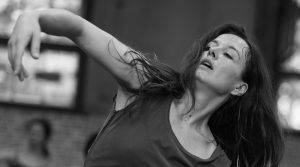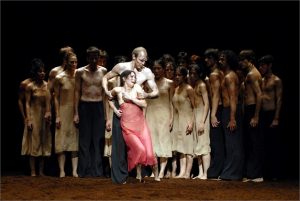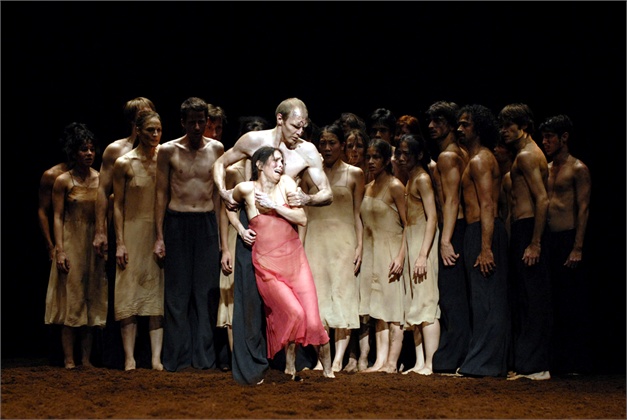It has now been a week since I arrived in Berlin. B12, the new contemporary dance festival, began here on June 26th. Born two years ago as a “small pilot project,” in the words of the festival creator and choreographer Johannes Wieland, the festival now offers over forty movement workshops taught by internationally acclaimed artists and educators. Located in the Eden studios– aptly named for the unexpected green haven surrounding the three dance studios only five minutes away from the Pankow station–the festival will be running until July 16th. Never have I experienced anything quite like it.
I had the amusing discovery of the festival’s slogan on my first day here: “B12: Research or Die.” Indeed, the particularity of these workshops lie in their focus on research, both personal and collective, both introspective and generative. Research that is physical, but also intellectual and emotional. Instead of the traditional 90-minute to two-hour dance classes, the four-day workshops last four hours. This gives the time for warming up the body, learning choreographic material and repeating it, but also for improvisation, for observation and discussion, and for creation. Dancers are asked about their experiences, asked to generate material themselves, and invited to get to know each other through movement.
Of course, the phrase “Research or Die” can be perceived as extreme. We joke about it. But in it lies a true dedication shared by all the teachers, and to a certain extent all the participants as well. There is an unspoken but palpable agreement that the work done by these artists– in search for their extremes, their most honest selves, their many different inhabited states, and always eager to share their discoveries—has indeed become indispensable for them. If it is hard to think of a dance festival as a matter or life of death, it becomes clear that through their questions, practices and aesthetics, these choreographers define their humanity. Discussions with Gallatin professor Laura Slatkin about the Iliad come to my mind. Homer’s poem is both a realization and celebration of what it means to be mortal, and how this mortality defines us especially when opposed to the Gods’ eternal lives. Though we are so far from the Trojan War, from that battle field, we still connect to it, for it does not concentrate on death (though there are many), but on the consequence of our mortality. Here, there is something about the search for extreme physical states and discovering our limits, the limits of our living bodies, that makes us feel more alive than ever. In both cases, we know that our flesh and bones will not exist forever.
“Research or die” also made me smile as I am here in Berlin thanks to the Dean’s Award for Summer Research. However, the first few days in the city and festival made me realize that I would have to seriously sharpen my initial focus. Originally, the idea was to observe the evolution of contemporary dance in Germany since Post-War expressionist dance and dance-theater. The festival invited Thusnelda Mercy, a member of the Tanzteater Wuppertal Pina Bausch company, one of the most prominent dance-theater companies founded in Wuppertal in 1973. Like many dance-theater pieces from the 1920s onwards, it has been understood that the historical context of Post-War Germany informed Pina Bausch’s work. I was interested in seeing to what extent this context still informed today’s creations. I was also looking forward to meeting newer German choreographers, to see if their own work was also informed by the past or current political and artistic context (including the refugee crisis which Germany has had to adapt to greatly in the past years).
It did not however take long to realize that this was a much too broad topic for this research paper, if not an impossible one to defend honestly. First of all, some similarities I drew between artists were not necessarily related to their nationality or culture, since other workshops taught by people from all over the world shared them as well. Secondly, the contemporary dance scene in Berlin is so huge and varied that coming to a conclusion about the influence of politics on contemporary dance in Germany would have been inaccurate. To give one example of this: last Thursday night, I went to support a friend at a dance battle. These competitions- opposing teams or solo artists- happen in small theaters or clubs all over the city. During this single battle, I watched as dancers performed break-dance and hip-hop, lyrical contemporary, vogueing, and flamenco-based improvisations. All of these can be placed under the category of German Contemporary dance. I therefore understood that my initial idea would have to change.
I did nonetheless proceed with interviewing Thusnelda Mercy after taking her workshop, and asked her about the influence of political context on Pina Bausch’s work. I was curious about the relevance of certain pieces today. Could some pieces simply not be presented to audiences forty-four years later, in a completely different setting? Were they still relatable? Were they timeless? Her response, which I was not expecting, allowed me to take a new direction. She told me that it was not the different context that made certain pieces difficult to re-stage. In fact, the professional answer would be to say that all the works can be re-staged, because even though Pina Bausch died in 2009, the company has the means and material to present these works if commissioned. However, her personal take on the matter was that certain creations had been so dependent on who had been part of the creative process that she thought it difficult to re-stage them. Dance-theater is not only about learning steps. During the workshop she taught, we were asked to create material based on our fears, on our memories, on our passions. These are difficult to perform honestly if one does not experience the initial steps of creation. This is why she thought some pieces would be challenging if not impossible to stage today, and therefore would be lost, as they should. However, Bausch choreographed over 45 dances, including some constantly performed throughout the entire world.
This takes me to what I believe to be the revised focus for my paper. One of these pieces is the Rite of Spring. Choreographed in 1975, the piece is Bausch’s adaptation of the original ballet and orchestral concert composed by Stravinsky and choreographed by Nijinsky in 1913 for the Ballets Russes. Thusnelda told me that she believed this to be a piece that was very successfully re-staged. In fact, it is coming to New York City’s BAM theater in September, and an NYU Tisch alum who joined to company last year will be performing it. I will be interviewing her, as well as a dancer I met here in B12 who learned and performed the piece ten years ago, in order to compare both experiences. I also hope to speak with Kenji Takagi, one of the Rehearsal Directors for this season who was a former member of the company. And then, to attend the performance in New York. My aim is to compare these experiences, learn more about the process of re-staging a piece once its choreographer has passed away, and perhaps identify the particularities of this choreography, and what makes it indeed so timeless.




Your research sounds amazing and immersive so far and I am glad you were able to smoothly find a different path, once the first one didn’t quite work anymore. The sharpened focus is fascinating and I am looking forward to hearing more about it! It is so special that you get to access different entry points into this piece and get a taste of its longevity (even as something like live performance is in a way so ethereal and temporary). Sehr schön!
Thank you Leah. I have to say that I questioned whether or not I should change my focus and though my research and interviewing process has been so incredibly satisfying (which makes me feel like it was the right choice on a personal level), I’m also relieved to read your comment and see that it’s interesting to others as well! I feared that going into this specific piece and artist would maybe not interest as many people at first…but it seems now, after discussions with dancers and artistic directors performing and teaching the piece today (see my second post) that it is as universal and relevant as I hoped it would be! looking forward to hearing about your trip!!
Excited to see your research evolve! I think studying the intricacies of carrying on an artists legacy be it choreography, musical performance, etc. is really interesting and I look forward to reading what you learn through your experience.
Thanks Shayna! Yes, it’s proven to be really captivating. I’ve thrown myself into this woman’s life and work, to the point of having to much to look into and discuss- the joys of research!- but all will be condensed for the paper. I’m getting very excited to discuss it with you all. Hope your research is going well also!